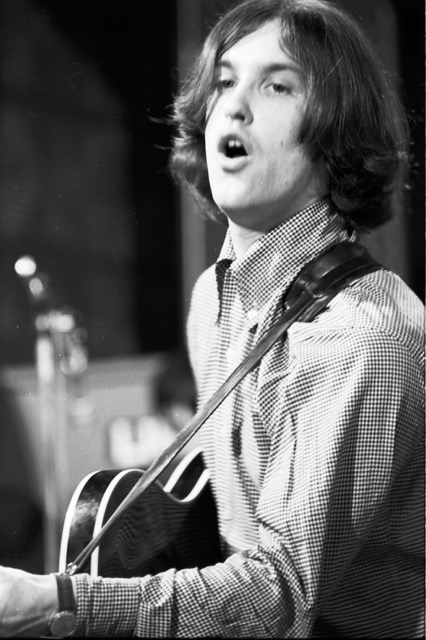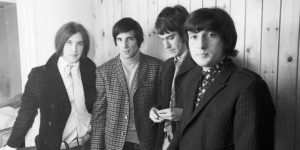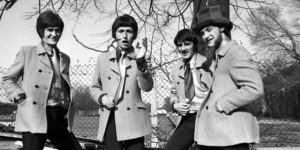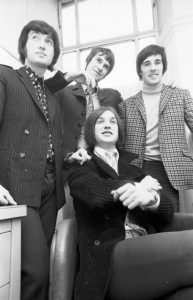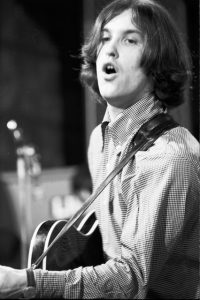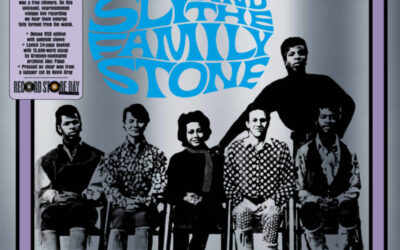By Harvey Kubernik c 2017
The Kinks-The Mono Collection, the first 10 albums on vinyl by the Kinks in glorious mono is now out, via BMG,
including the previously out of print in the U.S. mono mix of Live At Kelvin Hall.
The stellar product also includes the bonus double LP compilation The Kinks’ (aka ‘The Black Album) along with a lavish hardcover 48-page book including never-before-seen photos and new interviews with Ray Davies, Dave Davies and Mick Avory.
With the recent renewed interest in analog recordings in the vinyl format, these essential Kinks albums have been collected together, as their original vintage 1960s equivalents continue to command major sums on the collectors’ market. From the real-time invention of the punk and heavy metal riff on “You Really Got Me,” “All Day And All of The Night” and “I Need You,” the melodic mellotron swirls throughout “Autumn Almanac” and “Days” to the bold brass characterizing “Victoria” and “Shangri-La,” the full spectrum of The Kinks In Mono is here to be appreciated and enjoyed anew.
Brash, loud, quirky, reflective – are just some of the opposing adjectives that have been applied to The Kinks. While hailed as one of the great British singles bands of the 1960s, the superlative run of albums they released during those years chart a fascinating career trajectory – from young, white London boys emulating black Chicago R&B on their debut through to ambitious thematic works like The Village Green Preservation Society and Arthur that anticipated Ray Davies’ ambitions in film and theatre.
In between, Kinda Kinks and The Kink Kontroversy testify to the relentless, white hot pace of creative output demanded by their U.K. record label Pye in the mid ’60s (both were released within the year 1965). Face To Face and Something Else by The Kinks’ illustrate Ray Davies’ vision expanding beyond the traditional ’60s pop format, containing such evocative character vignettes as “Rosie Won’t You Please Come Home”, “Two Sisters” and “David Watts.”
There was even room in the catalog for a primitively recorded but excitingly executed audio vérité concert document (Live At Kelvin Hall). The quality of the albums was further bolstered by the inclusion of such timeless Kinks hits as “You Really Got Me”, “Tired Of Waiting For You”, “Till The End Of The Day”, “Sunny Afternoon” and “Waterloo Sunset” as well as Dave Davies’ solo emergence with “Death Of A Clown” and “Susannah’s Still Alive”.
Throughout the 1970s and beyond these classic recordings were mainly available in stereo – sometimes re-channelled stereo which blunted their dynamism. This state of affairs overlooked a key thing – the albums were originally conceived with mono in mind.
Unlike America, until the late 1960s, stereo was considered something of a novelty in Britain. For the leading players in the British beat boom, all efforts were directed at perfecting recordings made to be heard on radiograms, Dansettes and tinny transistor speakers. “I wanted the tracks to sound how we would play them live,” Ray says of the Kinks’ early recordings. “I wrote lots of songs for a particular sound and production.” Adds Dave Davies about their mono incarnation, “I do like the sound. There’s a certain power about it.”
“While folks forever sing praises – as, of course, they well should – over such stellar audio hat-tricks as Rubber Soul/Revolver / Pepper, Bringing It All Back Home / Highway 61 / Blonde On Blonde and Beggars / Let It Bleed / Sticky Fingers, I for one would just have to place the Kinks’ Village Green, Arthur and certainly Lola Versus Powerman et al albums right on up there too,” claims veteran Kultist Gary Pig Gold. “They also certainly, along with their immediate predecessors Face to Face and Something Else prove Sir Raymond Douglas Davies to be, for starters, every single bit the perfectly, powerfully-popping ultra-prolific tunesmith as Townshend, Wilson, or even Lennon.
“Let’s remember though, while we’re at it, the proto-metallic six-strung stylings of brother Dave who still, for some utterly unfathomable reason, isn’t muttered under the same accolades as Page, Beck, Clapton or even all non-ex-Yardbirds cranking up to 11 out there: the younger Davies was, and remains an enormous element within the venerable Kink Wall of Racket … which can still be heard every time a band unforgivingly overloads your favorite mobile device.
“And how better to experience all this nicest of noise anew than on the gloriously single-channel, made-to-melt-the-nearest-AM-radio-speaker Mono collection, which now can take its proud place alongside those similar big Beatles, Stones and Dylan no-stereo-allowed boxes. From ‘Beautiful Delilah’ and ‘So Mystifying’ clear on through ‘Arthur’ himself – not to mention all those delightful A’s and B’s on the Black Album bonus set – this IS The Kinks as God, or some even bigger music buff up there, intended. P.S.: and by the way, I’ll easily pit Live At Kelvin Hall right against Got LIVE If You Want It, any old time you choose it.”
“If I’m not mistaken, I believe Ray Davies on either Shindig! or one of the other American TV shows, was the first time I saw an effeminate man,” offers writer and Tam Tam Books publisher, Tosh Berman. “The odd thing, as a child, I was surrounded by various members of the gay community – yet, I never ever give it a thought till I saw Ray Davies performing ‘All Day and All of the Night.’ The limp wrist and the expression on his face were intriguing to me, and I think it was the first time that I became conscious of gayness as well as camp.
“Many years later, and as an adult I finally saw the Elvis performance on early 1950s TV, and he too had a certain amount of feyness or provocative sexuality. It wasn’t exactly a man’s sexuality, but something that went beyond gender or having a preference for a specific gender. Ray Davies carried that through with his early and mid-period performances with the Kinks,” Berman stresses.
“From an early age, I purchased Kinks singles as well as their Reprise albums, which were their American label at the time. Oddly enough and many years later, it strikes me ironically that the label was owned by Frank Sinatra. Was he aware of these dangerous artists, and what they are doing to a child and a teenager’s brain? I’m pretty sure that the albums I purchased, say from 1965 to maybe 1967 were in mono – due that our family just had a mono record hi-fi set. We had one huge speaker, and that is what we used for aural pleasure.
“As I became a teenager, I gathered the importance of Ray’s songwriting talents. I instantly knew that here was an artist or pop star of great importance. Yet, totally ignored by the masses from some odd reason. Was it his limp wrist and the addition of his songs becoming more British obsessed?
“I fell out of the Kinks orbit sometime during the recordings of Face to Face album,” confesses Tosh. I think it was a year later (which for a teenager in the 1960s is a lifetime) that I came upon their album Village Green Preservation Society. I bought it because the cover was intriguing to me, but I wasn’t expecting too much out of it. Yet, it was a sense of brand loyalty that probably made me pull the cash out of my pocket that day. When I got home and played this album, on a proper two speaker set – up (known as a stereo) I was transported into another world.
“I think I was 14 or 15 at this point, and I never heard anything so emotionally moving as that album. The slightly psychedelic overtures on the album, as well as the lyrics being totally focused on the issues of the English consciousness was something that really floored me at the time.
“To this day, it is one of my all-time favorite pop albums,” Berman acknowledges. “I never tire of the melodies as well as the tragic narratives in the songs. ‘Do you Remember Walter?’ struck me as something very profound and totally moving. ‘People Take Pictures of Each Other’ was another track that was so truthful to me. As I got older, it seems that the album is totally about observation and not actually living in life. It is sort of like Proust eating that cookie, which caused one’s memory to come back in full force – but you’re living in a life of memory. In fiction writing that is not a rarity, but in a pop album context, it was truly unique and of course brilliant under the genius of Ray Davies.
“About ten years ago, I started getting back into the groove of buying vintage vinyl. I think for the purpose that I totally miss the beauty of having a huge object in my hands, and placing the object (LP) within the bigger object, and playing it on a machine where you have to clean off the dust – it became a chore, but from that job I get a beautiful sound filling the room or the pair of headphones.
“Over time, I purchased the Reprise mono editions of the Kinks albums because it seemed to me that their production/sound was meant to come from one direction. The early albums on mono are very powerful. You don’t need an expensive set-up to appreciate the magic that comes out of their vinyl groove. The Kinks are something that is totally magical, yet, like a good Harold Pinter play, also very absurd. Ray and company opened up a world for me, and I entered, and I eventually closed the door behind me.”
A few years ago in Central Coast California, while visiting English and Literature Prof. Dr. James Cushing at Cal Poly San Luis Obispo, just before his radio shift on KEBF-FM in Morro Bay, I was taken by a comment the Poet Laureate of SLO said when he touted the Kinks’ Face to Face LP issued in late 1966: “Was any band ever less 1967-oriented than the Kinks? The schoolboy envy of ‘David Watts’ and the family jealousies in ‘Two Sisters’ or ‘Situation Vacant’ belongs more to the James Joyce of Dubliners than to any utopian revolutionary acid vision. Yet the range of music these songs represent equals Sgt. Pepper’s.
“I was struck by how much Village Green Preservation Society feels like the original cast album to a West End musical,” explains Cushing, “or the soundtrack to a kitchen-sink-realist black and white movie about life in a London suburb. The lyrics in each case describe a character, a situation, a dramatic scene every bit as well as ‘Eleanor Rigby’ does, only the sense that each song fits into something bigger, like a larger narrative, is tangible. The Kinks would do this ‘something bigger’ manifestly in Arthur and Percy, but it’s all here,” Cushing marvels.
“One conclusion I draw from this is that, despite ‘You Really Got Me’ and ‘All Day and All of the Night,’ Davies isn’t essentially a Rock guy at all, but a Theatre guy who formed the Kinks in order to use rock as a tool to get his vision over to as large an audience as possible. The Kinks are a personally resonant subject for me, not something I take lightly.
“They were the third British band I got into in 1964 after the Beatles and the Stones, and I can see the 11-year-old me listening to the first LP (U.S. Reprise edition, mono), dancing alone around my room in Westport, trying to figure out the secret meanings of ‘Long Tall Shorty’ and ‘Got Love If You Want It.’ Formative experiences! Before the Cushings moved to L.A. in 1967, I had acquired the U.S. editions of Kinda Kinks, Kinkdom, and Greatest Hits, the last-named a present I received at a farewell-to-Cushing Xmas party some of my school friends threw for me. I played them over and over again, fifty autumns ago.
“Unfortunately, in 1966-69, when the Kinks were barred from playing the U.S.A. because of that union problem with the American Federation of Musicians, there was so much amazing new music from new artists like the Doors, Hendrix, Airplane, Zappa, Spirit, etc., that the Kinks fell off my radar.
“In 1969, I heard ‘Picture Book’ on a Warner Bros. compilation LP and liked it well enough, but competing visions of the revolutionary seemed more fragrant and beguiling than nostalgic contemplations of the past. In 1971, I also enjoyed ‘Lola’ on KRLA, but didn’t go any further. Why? Blame it on blues, I suppose.
“Forty-five years gone by, I see the Kinks as a ‘lost chapter’ in my rock life, just as they are in many ways the great ‘lost band’ of the 60s.
“I’ll just say that The Kinks were great and still are, that they sound good in mono or stereo on vinyl or CD, and that Ray Davies belongs in the same British genius songwriter category as Lennon-McCartney, Bowie, Strummer, Drake, Costello and whoever wrote ‘Downtown’ for Pet Clark.
“Did any band ever have worse luck,” laments James. “Being banned by the American Federation of Musicians from touring the U.S.A. for three years! The release date of Village Green Preservation Society pushed back until November 22, 1968, the same day as the Beatles’ White Album! Arthur, the BBC TV special that never was!
“I saw them in concert once, in San Francisco, at Winterland in 1973. They were so disgracefully drunk they could barely manage to get through a single song. I walked out. So what? I saw the Kinks!
“Ray Davies made up for it years later in Los Angeles, at the Wiltern Theater, where he was delightful. Ray opened with the 1966 B-side ‘I’m Not Like Everybody Else,’ which is the international anthem for intuitive kids.
“Listening to Arthur on CD this morning, I was struck by how orderly Davies’ mind is, how nicely he matches lyric with music – reflective, anthemic, aggressive. I was also struck by the depth of his satiric impulse, which is unmatched in British songwriting of the period and has its U.S. counterpart in Zappa, whose sense of humor is radically different.
“Finally, the CD includes contemporary non-LP singles and B-sides, which effortlessly take on independent existences outside the narrative concept of the Arthur album. Davies understood that an album is an album and a single is a single,” Cushing concludes.
“Sir Ray’s now got his Knighthood and while chart success came quickly for The Kinks in the fall of 1964 both at home and in America with “You Really Got Me,” the band’s immediate reward the day after their #1 chart conquest was a near fatal car accident driving to a gig in Manchester. They were saved by a sturdily built, fast accelerating Jaguar,” volunteers Michael Fremer, editor, www.analogplanet.com.
“They were also signed in America to Frank Sinatra’s Reprise records, which in 1964 knew very little about selling rock to teens—though with the help of Kinks fanatic John Mendelssohn the label tried its best.
“The group abruptly shifted from hard rocking to gentle nostalgia with The Village Green preservation Society…one
of the group’s greatest albums, but one the public didn’t get. Mainstream success finally came again with ‘Lola’ but not before Coca-Cola sued for trademark infringement.
“Ray’s drift into music hall style rock opera lost many original fans but brought the group arena rock success,” Fremer suggests, who is also a senior contributing editor to Stereophile.
“So yes The Kinks should have been ‘bigger’ but with the just released vinyl box set containing the core Pye/Reprise gritty yet unerringly melodic catalog in glorious mono mastered from the original analog tapes, it’s time for oldsters to get back, get back, get back in the line, and for youngsters to start appreciating the peak output of one of the greatest ‘60s era bands. God Save The Kinks!”
Photographer Heather Harris on the Kinks:
“In one week of meeting fellow UCLA-ite gone Music Biz insider John Mendelssohn at his 1970 History of Rock extension class I had been introduced to the best of the Who, the Kinks and the Stooges. Heady stuff for the teenaged me! I gratefully give credit, as my life later intertwined for its infinite betterment professionally with Iggy and Stooges, plus personally with The Dreaded Mr. Twister, then a wild singer often mentioned in the same terrified breath as Iggy Pop and who fronted Mendelssohn’s band Christopher Milk. He was the one who always got the most press, he was just that good.
“Who/Kinks/Stooges were hardly at the forefront of early 1970s’ critical acclaim in the U.S. at the time. It took a contrarian like Mendelssohn to appreciate what these three stylistic outliers had concocted outside of the mainstream music markets, despite earlier pop chart hits by the first two.
“For a while, it was a 2-way street. His pithy music journalism had earned jobs escorting The Who, junkets to document the Stooges, and a rightful position as Warner Brothers liaison for the Kinks, since, in his always entertaining self-mythology, it had been written in Rolling Stone (when it was Important) that upon hearing the initial five guitar power chords of ‘You Really Got Me’ on his car radio for the first time in 1964, he nearly drove off the road in excitement. Kinks music was just that powerful. He later became Kinks Kronicler #1 for assorted album releases or media dispatches and continued to spell anything he could with a “K” therein.
“My own reaction was to bellow along with ‘Vic-TO-O-O-OR-i-aaaah!!!!’ from the Kinks’ then brand new, wonderful Arthur album along with my college chums, none of us, it should be noted, being capable pitching any notes actually on key vocally. It was just that joyous.
“Jump cut to a month later. Ray Davies and I were thrown out of a bar together in Hollywood, California, 1970. He didn’t have his passport for identification, and I was still under-aged. Mendelssohn stayed inside drinking with Dave Davies. He was just that cozy with ’em all.
“Jump cut to 1974. The Kinks playing the Santa Monica Civic Auditorium, Santa Monica, California. I photograph Ray Davies singing while trying to balance a now empty beer can atop his own noggin. It was just that funny.
“Jump cut to 2010. Ray Davies, live at the Canyon Club, Agoura Hills, California. Mr. Twister and I perversely are turned down for photo passes. Modern micro-management is just that misguided.
“Jump cut to 2015. Dave Davies performing a full, rip-roaring to emotionally resonant set with his band at The Roxy, Hollywood, California. He was the poster boy for ‘comeback kid’ after a self-admitted, quite debilitating stroke. Mr. Twister and I happily photographed this show thanks to this Kink’s journalist girlfriend Rebecca Wilson who also aids in promotion. We kicked back some great shots, better than any in the rest of the tour. Yes, the selfsame Mr. Twister of 1970 in the first paragraph: 46 years after meeting and 41 years after initial hookup (it took me 5 years to scrape the groupies off) we are still together, photographing or otherwise. He was and is just that amazing.
CODA: Post Kinks’ breakup, all Kinks persist in fraternal sniping to this day, dispelling fans’ hopes of a full on Kinks reunion despite every other contemporary of theirs having done so. Fantasy Football-wise, I somewhat could envision a gala one-off Kinks show for charity in three parts: solo Dave Davies band set, solo Ray Davies band set, then Kinks Reunited set. Anything else would be asking too much of these great artists who already have given us some of the best music that ever has existed. And the Kinks were just that important…”
-Heather Harris, December 8, 2016
Fairfax High School graduate and former Los Angeles City College student, the trail-blazing producer Shel Talmy, had plenty to do with the sonic information The Kinks In Mono contains.
“I started as an engineer with [owner/engineer] Phil Yeend at Conway studio in Los Angeles. He trained me on three-track. Conway had a good echo chamber,” Talmy reinforced in a 2015 interview.
At Conway, Shel worked with surf bands like the Marketts and music legends arranger and multi-instrumentalist Rene Hall and producer Bumps Blackwell. At Capitol studios in 1962, staff producer Nik Venet allowed Shel to watch a recording session he supervised with Sam Cooke and Lou Rawls.
“Lou and Sam Cooke were fuckin’ brilliant. I would hear how Nik would talk to artists and the engineers. And I have done that forever. I returned the favor when I went to London in 1963. I wrote to Nik and said ‘there’s a band called the Beatles you really got to take a listen too. I think they are gonna be enormous.’
“Never heard another word. 30 years later I ran into Nik at a studio and he told me when he got my letter he ran into Alan Livingston’s office, the head of Capitol Records, and badgered them into signing the Beatles [for North America.] Nik signed the Beach Boys to the label in 1962.”
In London during 1963, Talmy first met the Kinks, formerly the Ravens, through their manager, Robert Wace.
“I brought with me from Conway a way to using the equipment of making everything apparently louder than it actually was. I did that with bringing up a guitar through channel one, which was right at the beginning of distortion and the other one which was normal. So I used to bring up the distorted one underneath the good one and the entire level went up. And I always tried to do everything I could without distorting. So I was always near the red line of the meter. I brought that with me. I liked hearing records where I think it actually expands the vocal audio range of what you’re hearing.
“In London, I spent a lot of time [with the Kinks] trying to perfect the sounds we were getting at Conway. We spent time isolating instruments, working on drum sounds and guitar sounds, in terms of days and hours. Microphone placements we did at Conway were utilized with the Kinks and Who.
“Ray Davies of the Kinks at that point in time was the most prolific songwriter I’ve ever known. He’d go home and bring you back a dozen songs the next day. What we used to do was sit down, in a studio, and he actually played piano, not guitar, and he’d play me the stuff. I heard four bars of ‘Sunny Afternoon’ and I said ‘that’s gonna make number one.’ He’d play me songs. ‘That’s good.’ ‘That’s not quite there yet. Let’s put that aside.’ He went along with that. We never did demos. Sitting down and playing the stuff live,” he underscores.
“[Guitarist] Jon Mark was already influenced by Indian stuff. And I played a recording he did to Ray. And Ray came back the next day with ‘See My Friends.’ We had to tune down the regular guitar and double-tracked it for a kind of sitar sound. It broke a lot of ground,” reflects Talmy.
“For years I’ve been saying that Dave Davies is probably the most underrated guitarist in rock ‘n’ roll. He’s a damn good guitarist and a very good songwriter.”
Harvey Kubernik and Dave Davies interview
HK: Feelings about the Kinks’ mono records and stereo records. Is there a preference?
DD: I like them both for different reasons. The mono always sounds like it did when we recorded it and were there doing it. But the stereo versions are equally as exciting in a different way. I’m not gonna get on this mono-rules bandwagon. All these great records are moments in time that should be appreciated for what they are. I think people will realize a lot about the times by listening to the mono, it captures the atmosphere and feelings of a very exciting spontaneous and momentous period in history.
HK: In some quarters, the Kinks’ sound was really tailored for mono.
DD: Yeah, absolutely but mono was all we had anyway. They do translate well to stereo too but I prefer the mono recordings and I hope everybody enjoys it.
HK: Observations on vinyl. Like the new box set. A fan of vinyl?
DD: At the time when stereo was introduced I thought it was just a quirky fad although later I grew to realize its importance. It enhances the music. I like both stereo and mono vinyl. I don’t like CDs to be honest although I’ve made quite a few new albums on cd over the years but I was delighted that people started to reissue vinyl. I think it’s a step in the right direction even down to the artwork. The covers were pieces of art that you could put on your living room wall and enjoy it as you would a piece of art. That’s what’s so special about the artwork on Arthur and all of them. You have to remember that although I’m immensely proud of the music the art is a very important factor. If you saw the original art for Arthur in an art gallery you’d say WOW! There’s about four five six seven can’t remember pieces of art that went into the album cover artwork for it.
HK: A reflection about initially touring America in 1965 period and returning in 1969. Initial impressions of America and U.S. AM radio of 1965. In 1969 the Kinks were on the influential FM radio dial. U.S. radio must have really been a discovery for you.
DD: Recently Richie Unterberger showed me some correspondence from the Rock and Roll Hall of Fame archives between radio people and Kinks management from the mid60s that showed they were concerned about whether to play our material on the radio or not as they regarded us as unpredictable. FM radio was more open minded about what rock music they play which included more Kinks airplay and this followed through to the 70s when “Lola” was out and we got fabulous FM radio support in America. American radio was so different.
I went to America with the excitement and expectation of all the great music I grew up with and more and radio seemed pretty bland in the mid60s except for the Byrds and Lovin’ Spoonful and Dylan I guess. But they weren’t played heavily on the radio. I think FM was a shot in the arm for everybody. Radio Caroline in England and other pirate radio stations were a revelation and I grew up listening to Radio Luxembourg.
HK: I wanted to ask about the difference in writing a song as opposed to writing your autobiography. Song lyrics versus prose and memoir writing.
DD: Writing my memoir was a totally different approach than song writing and I enjoyed it. I like writing poetry and songs and I do prefer it to structured writing. I like unstructured random prose. I’m utilizing that style in some new work I’m doing.
HK: Three of your most poignant compositions are in the new box set. “Love Me Till the Sun Shines,” “Death of a Clown” and “Susannah’s Still Alive.”
DD: I love writing. Ray wrote some amazing songs but I was also a prolific writer as well. The only problem we had was too many ideas. I’m proud of those songs and they should be there because my contribution is valid. What should I say that the sky is up there and the ground is down there. It’s obvious.
I love these songs and they are still an important part of the Kinks heritage. “Love Me Till the Sun Shines” was about the times, the need to be loved and having relationships with partners and a love that’s based on freedom. “Death of a Clown” was about how I felt at the time. I suddenly realized that I felt like a clown in a circus, going to parties, going to one place then the next, pitching up tent, then pulling it down again, moving on. It’s about disillusionment. “Susannah’s Still Alive” was a song about reflections based on how I felt about my first girlfriend.
HK: Can you shed some light on the songwriting process or recording of your tunes.
DD: I write from the heart, sometimes I get good ideas, sometimes I get ideas I don’t like but once you start trying to write you should always try to finish something even if it was shit or first recorded on a cassette player or a professional lap top program. The main thing is to get the ideas out there because if you don’t they’ll fester in your mind and drive you crazy or you forget them.
HK: I wanted to ask about producer Shel Talmy.
DD: I saw him recently in LA when I did a show at the Roxy. It was good to see him and he seemed great. His eyesight has always been poor and has gotten worse but thankfully his hearing is still impeccable. I thought he really helped us in the beginning and he was good to have around in the early sessions. I always appreciated how he supported me and has praised my amp sound, guitar playing and solo on “You Really Got Me.” He’s a good guy.
HK: Over the decades, I’m sure you’ve signed your share of Something Else and The Village Green Preservation Society LP’s and CD’s. What was happening in your band at the time that yielded such terrific work? I saw the Kinks in 1970 at the Santa Monica Civic Auditorium. Second row orchestra pit seats. You opened with “Last of the Steam-Powered Trains.” It was like a living history lesson on stage by a bunch of visiting English music teachers.
DD: We all got on really well and me and Ray were very supportive of each other both creatively and emotionally and that was the mainstay of the band, our mutual support of each other. It filtered through the music, our family support as well.
HK: Did you ever have a theory about the role of your guitar playing in the band as well as your backing and lead vocals?
DD: We just did it. We all just did it. It wasn’t a plan or contrived. It was organic. We got together and we seemed to know what to do at the right time. I always thought me and Ray’s voices sounded great together because apart from having different voice registers, it helped us when we did harmonies and octaves. Ray would often do the main vocal in a lower octave and I did a higher octave depending on what song we were doing. I got a higher range than him. On guitar everything complemented each other in a very natural way. It wasn’t contrived. Ray evolved a different style of playing to me.
HK: You are working with your sons Russ and Martin Davies.
DD: I have two projects coming out this year that are independent of each other I would like to talk about. Open Road is an album that me and my son Russ Davies have been working on over the last year. We started in June 2015 and finished October 2016.
Russ is a prolific artist in his own right and has produced several great albums, and working together on this has been one of the most exciting music projects I’ve ever worked on, and I’m expecting great things for it. It’s a rock album which is melodic, sensitive and uplifting. It is being released in March 2017 on Bob Frank’s Red River entertainment label. I am touring the U.S.A. to support the album beginning in April, with hopefully more U.S.A. and U.K./Europe dates in the summer and later in the year.
Second is a film project called Strangers by my son Martin Davies.
Dave Davies has U.S. live dates that will be taking place this April. (more dates to come check website davedavies.com for updates)
April 6th, 2017-Milwaukee, Wisconsin-The Northern Lights Theater
April 8th, 2017-St. Charles, Illinois-Arcadia Theatre
April 11th, 2017-NYC, New York-City Winery
April 12th, 2017-NYC, New York-City Winery
April 13th, 2017-Natick, Massachusetts-Center for the Arts
April 15th, 2017-North Truro, Massachusetts- Payomet Performing Arts Center
April 20th, 2017-Londonderry, New Hampshire-Tupelo Music Hall
(Harvey Kubernik has been a music journalist for over 44 years and is the author of 8 books. During April 2017, Sterling will publish Harvey Kubernik’s 1967 Complete Rock Music History on the Summer of Love).

